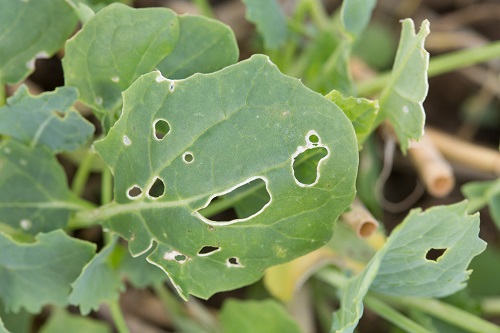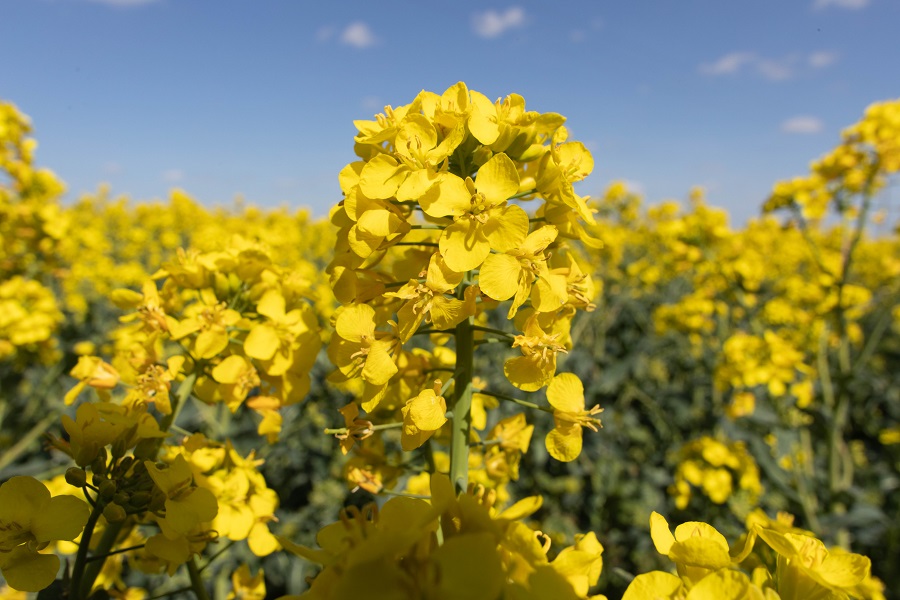2020 was an incredibly difficult year for OSR growers, which was largely blamed on cabbage stem flea beetle. However, new research indicates the causal factor may actually have been something quite different. CPM finds out more.
Perhaps it could be worth persevering with OSR?
By Charlotte Cunningham
If working out the key suspect responsible for the massive loss of oilseed rape yields last year was a game of Cluedo, it would go a little something like … “it was the cabbage stem flea beetle, with a very hungry appetite, in the early growth stages.”
However, though the pesky flea beetle has been the main suspect for the past few years, new research from BASF and ADAS has shown that the real yield killer may perhaps have gone slightly undetected.

New research has shown that the weather was the causal factor of 2020’s poor OSR yields
BASF have had a long-standing relationship with ADAS, helping to fund valuable research into the key components of OSR yield, and the factors that can influence it, in a bid to drive better management of the crop on farm, explains Clare Tucker, business development manager BASF. “One of the pieces of work we did with ADAS was to look at the significant weather factors affecting yield – particularly focusing on what periods increase or reduce yield – to enable us to explore further the management strategies that ought to be put into place to combat negative factors.
“But then flea beetle comes along and throws a spanner in the works, and with the yields of last year’s surviving crops so incredibly low, it was quite logical to put that all down to the pest.”
But actually, the science indicates that it may in fact have been the weather that was the major cause of poor yields last year, though this did exacerbate the impact of the CSFB, she adds. “While that doesn’t bring the lost yields back, what it does show is that 2020 was just an incredibly unlucky year, and perhaps it could be worth persevering with OSR.”
Though last year was undoubtedly incredibly difficult for OSR growers, Dr Pete Berry, ADAS’ head of crop physiology, says it wasn’t actually the worst – in terms of average OSR yields. “2001 takes that accolade,” he laughs. “But it’s not a coincidence that 2001 had a very wet backend too. And so while damage caused by CSFB undoubtedly made a significant contribution last year, we’ve found that the weather was the key factor in determining yields.”
Meta-analysis of data from the past 40 years has revealed both the ‘perfect storms’ and ‘ideal conditions’ leading to the highs and lows of record-breaking years. The research also showed how, over these four decades, weather was responsible for up to 37% of the OSR yield variation and provided insights into OSR management – specifically designed to help crops cope with extreme conditions. “We looked at historic weather records and the national yield data, dating right back to 1979 as this is the first decent record of national OSR yield that we have,” explains Pete.
Statisticians then analysed the data and came up with five main weather characteristics which explain a lot of the variation in yield. These included:
- A high maximum temperature in Oct
- A dry Dec
- A warm minimum temperature in Mar
- A sunny and dry Apr and,
- A cool, wet May
“If we put a bit of detail on this and try and explain why those characteristics are associated with high yields, we can say that in the case of a warm Oct, we found that when it was 2°C warmer than average temperatures, the national average yield increased by 0.17t/ha – which is quite a lot for a single weather factor in a single month.
“This increase in yield ultimately comes down to increased autumnal growth, particularly root growth, resulting in stronger plants going into the winter months,” he notes.
The research also showed that an extra 50mm of rain in Dec was associated with a reduction in yield of 0.11t/ha – largely due to water logging. “If it’s wet in Dec, it’s likely that your crops are going to sit in wet soil for several weeks – possibly months – and we know OSR really struggles in wet conditions.
Apr is a hugely important month for OSR and 50mm less rain or 32 more hours of sunshine than usual was shown to lead to a yield increase of 0.2t/ha. “Dry conditions often just hold back the canopy development so you’re not getting an over large canopy and then the sun helps the crop to set lots of seeds/m2.”
Looking at May, the study showed that a cooler month helps prolong the seed-setting period – both pods and seeds per pod – and the wetter conditions ensures the crop has enough water during seed filling to fill all the seeds. “Increased rainfall of 15mm or temperatures 1°C cooler than usual were shown to be associated with a yield increase of 0.12t/ha. A dry hot May can be very detrimental to such a key stage.”
Applying these parameters to 2020 weather patterns, Apr was the only month that ‘played ball’ says Pete. “Even then, the sunshine was accompanied by a drought which caused a lot of stress for the crop.
“At the other end of the year, not only was Dec incredibly wet, but so were the months around it, which only prolonged the effects of waterlogging – and I believe this was the most influential factor in the low yields seen in 2020.”
However, it’s not just about knowing what the factors are that cause variation, but more importantly, how we manage crops to help them to withstand adverse weather conditions.
According to Pete, the starting point is maximising autumn plant vigour.
“To give OSR crops the best chance of coping with such adverse weather conditions, they need strong autumn growth and a healthy canopy for as long as possible.
“Choosing varieties with early vigour and maximising seed-to-soil contact and moisture availability at drilling, will help crops grow above and below ground. This strong establishment will enable them to cope better with cold wet weather throughout the autumn/winter and withstand more damage from CSFB.”
For protecting against increased rainfall, drainage is key, he adds. “But vigour will also play a role in resilience too.”
If growers end up with a wet Apr, then there’s the risk of getting an overlarge canopy which doesn’t help yield, adds Pete. “So delaying nitrogen fertiliser and using PGRs to manage the canopy becomes beneficial.”
Looking at May management, growers should maximise photosynthesis and canopy duration by using fungicides and late foliar N, as well as using PGRs to stimulate lower order branching to increase pods and seeds, he says.
While the research provides a somewhat comforting explanation for such poor yields last year, this undoubtedly leaves the industry wondering – but what about the beetle? “Obviously, the CSFB levels were very high and that was a major contribution to low yields, but not as much as the unfavourable weather,” concludes Pete.
In-field reflections.
When we look at how the research is reflected in the field, for Yield Enhancement grower, Adrian Joynt, drilling date is highly influential in establishment. Typically, he waits until the last week in Aug before sowing OSR on his 971ha farm in Shrops.
“For the past two years, it’s been wetter in Aug than in Sept here. CSFBs also seem to be moving into the crop in Sept rather than Aug, this combination means our later sown crops are not looking as good as the earlier drilled. It’s making me wonder whether I should bring drilling forward in future.”
Another OSR YEN farmer, Chris Eglington, achieves robust soil-to-seed contact by double, sometimes, triple rolling on his 304ha farm in Norfolk. “My OSR drill doesn’t like wet conditions so we try to drill when conditions are drier with the assumption that any rain that follows will kick-start growth.”
In 2020, monitoring of eight BASF Real Results fields showed how some low-yielding crops went backwards in Mar. “We suspect this may be due a combination of winter waterlogging impairing root function and low nutrient availability. Soils will have leached nitrogen during the wet winter months. Add this to late fertiliser applications and delayed uptake due to the drought in spring, and it’s no wonder crops struggled,” says Pete.
BASF Real Results case studies included a low yielding site with no CSFB larvae in spring and a comparatively high-yielding site with an average of 36 larvae/plant, providing further evidence that the weather was the key limiting factor for OSR yields in 2020.




